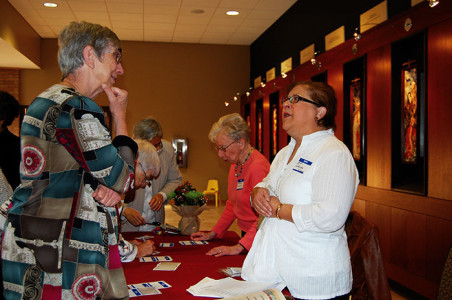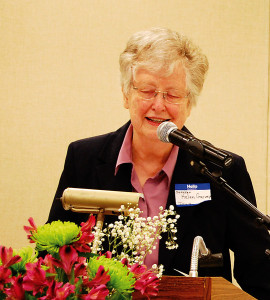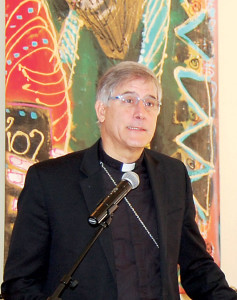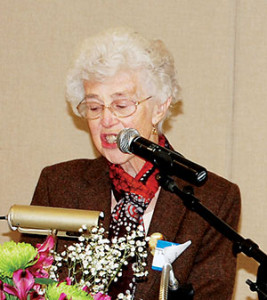By Elsa Baughman
JACKSON – Saturday, Jan. 17, was a special day for the religious sisters serving in the Diocese of Jackson. By 11 a.m. St. Richard Parish Foley Hall was already alive with the presence of about 25 sisters who were enjoying each other’s company. By 11:30, when the program was set to start, the room was full. The parish was honoring and celebrating the sisters for their service in the diocese with the program, “Women & Spirit: A Celebration of Consecrated Life.”

St. Richard Parishioner Dolores Ulmer (right) greets registants for the day.
In welcoming them, Father Mike O’Brien, pastor, told approximately 80 sisters that they represent hundreds of religious women who have worked diligently for many years building America, Mississippi, and building the Diocese of Natchez-Jackson and now the Diocese of Jackson. He said it was a great honor for his parish to gather and recognized them at the beginning of the Year of Consecrated Life.
Bishop Joseph Kopacz attended the luncheon and in his remarks noted Pope Francis letter for the opening of the Year of Consecrated Life.

Sister Helen Garvey (left) shares the story about the production of the exhibit “Women & Spirit: A Celebration of Consecrated Life” at St. Richard Parish Saturday, Jan. 17.
“The aims of the year are to reflect and always look to the past with gratitude, to live the present with passion and to embrace the future with hope.” There are changes between generations, Bishop Kopacz said. “As one generation goes to the next we celebrate what has been, what is and what it will be in the life of the church.” He added that in reading the signs of the time, we need to be open to the spirit working in our lives, in the world and in the church. “We are grateful and will continue to work together celebrating the past and embracing our presence,” he said.
The program continued with a presentation by Sister Helen Garvey, BVM, a consultant for religious congregations and past president of the Leadership Conference of Women Religious, (LCWR) on the development and production of the traveling museum exhibit “Women & Spirit: Catholic Women in America.” The exhibit has traveled the country from 2009-2011 sponsored by the LCWR.

Bishop Joseph Kopacz welcomed the sisters who attended the program.
Sister Garvey’s talk, peppered at times with humor, narrated with details of how she came to be responsible, reluctantly at first, of the task of producing the exhibit. The goal of it was to share the contributions of the Catholic sisters and how they helped shape the culture and history of the United States while at the same time showing their vision and spirituality in serving others.
Sister Garvey explained how, with no museum experience and no money at the beginning, she formed a committee from many disciplines that included historians, sociologists, administrators and artists from different parts of the country and different communities to help with this project. The committee was in charge of raising the funds, to produce the exhibit and collect the artifacts from the different religious orders who were serving in the United States, about 500, she said. Not all the congregations sent items to be included in the exhibit.
Sister Garvey mentioned that the Sisters of St. Joseph of Philadelphia, who are developme

Sister Therese Jacobs thanked the sponsors of the program at the end of the event. (Photos by Elsa Baughman)
nt experts, helped them raise one million dollars.
She mentioned that originally she wanted the exhibit to be shown at the Smithsonian Institute but since that was not possible one of the directors of the institute suggested they do a “charratte.”
She didn’t even know how to spell it or what it was. She said she was very worried but one of the lay women in the committee told her, “The sisters crossed the ocean, learned the language, built hospitals, schools and orphanages, and you are worried about a little ‘charrette’”?
(A charrate is an intense period of design or planning activity) So, she set to prepare the exhibit which was hosted by 15 states.
After the last exhibit, the group explored the idea of expanding the exhibit into a documentary of the same title.
The one-hour documentary is narrated by Cokie Roberts and shows photographs, letters, and artifacts dating from the first Catholic sisters who landed in Louisiana in 1727, the Ursuline Sisters and years later the Carmelite Sisters. The documentary also includes interviews with scholars, commentators and anecdotes from sisters working in today’s world.
Participants viewed the documentary and afterwards shared what impressed them the must about the content.
One of the sisters suggested that Sister Garvey write her story of how the exhibit and the documentary was made and the number of hurdles she and the committee had to endure to see the completion of the project.
Sister Donna Gunn, who served in the diocese for many years and recently retired to St. Louis, Mo., commented, “I worked with most of these sisters when I worked in Catholic Charities and it’s wonderful to see them again,” she said. “I am grateful to Father O’Brien and Sister Therese (Jacobs) for putting this event together. I think it’s a wonderful way to tell the sisters, ‘thank you for all the things you have done.” She said it’s good to know that somebody is recognizing their service. “We don’t do it for the recognition but when it comes it’s sweet,” she added.
The word for the day was “wonderful.” Every one of the sisters when asked what they thought about the event said it with joy and all said it was so very special to be able to see each other and meeting others. Dominican Sister, Trinita Eddington, said, “I think we need to do this every year because we don’t see each other very frequently and with time we lose touch.
Guadalupan Sister Lourdes Gonzalez, who serves in the Hispanic ministry at Jackson St. Therese Parish, noted she didn’t think there were so many sisters serving in the diocese and although she knows few of them she enjoyed being with them for first time. “It’s so nice to see all of us together here during this special event,” she said.
Sister Obdulia Olivar, MGspS, who serves in Forest and Morton, said, “It’s a great joy to be here and learn about the history of all those sisters who came to this country before me.”
Sister Therese Jacobs, BVM, pastoral minister at St. Richard, ended the program by thanking the sponsors: the Knights of Columbus, St. Dominic Hospital and St. Richard Parish.
